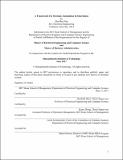| dc.contributor.advisor | Berthold Horn and Karen Zheng. | en_US |
| dc.contributor.author | Ben Nun, Shai | en_US |
| dc.contributor.other | Leaders for Global Operations Program. | en_US |
| dc.date.accessioned | 2017-10-18T14:42:42Z | |
| dc.date.available | 2017-10-18T14:42:42Z | |
| dc.date.copyright | 2017 | en_US |
| dc.date.issued | 2017 | en_US |
| dc.identifier.uri | http://hdl.handle.net/1721.1/111863 | |
| dc.description | Thesis: S.M., Massachusetts Institute of Technology, Department of Electrical Engineering and Computer Science, in conjunction with the Leaders for Global Operations Program at MIT, 2017. | en_US |
| dc.description | Thesis: M.B.A., Massachusetts Institute of Technology, Sloan School of Management, in conjunction with the Leaders for Global Operations Program at MIT, 2017. | en_US |
| dc.description | This electronic version was submitted by the student author. The certified thesis is available in the Institute Archives and Special Collections. | en_US |
| dc.description | Cataloged from student-submitted PDF version of thesis. | en_US |
| dc.description | Includes bibliographical references (page 79). | en_US |
| dc.description.abstract | Amazon's leadership has set a goal to achieve a highly automated warehouse by 2020. Automation involves two challenges, physical movement and decision-making. Decision making often increase variability, defects and consumes time. The goal of this paper is to offer a structured framework to design a machine-learning based solution to automate decisions. It will leverage recorded decisions made by Amazon's employees every minute. Using the stow problem as an example, the paper will showcase how captured decision data can be a source of knowledge about processes and products. The stow case is a perfect example for non-trivial continuous decision making process. The workers' decisions are recorded but to this day Amazon does not leverage them for learning purposes. Our framework will offer a few outcomes: 1) High accuracy decision model, improving forecasting abilities from 59% to 95% 2) Self healing mechanism and learning system 3) Coaching and training tool. Using only the first outcome, cost savings are estimated to be over $25M annually across the US network. This paper will also discuss the psychological implication for decision automation while keeping manual work as part of the process. | en_US |
| dc.description.statementofresponsibility | by Shai Ben Nun. | en_US |
| dc.format.extent | 79 pages | en_US |
| dc.language.iso | eng | en_US |
| dc.publisher | Massachusetts Institute of Technology | en_US |
| dc.rights | MIT theses are protected by copyright. They may be viewed, downloaded, or printed from this source but further reproduction or distribution in any format is prohibited without written permission. | en_US |
| dc.rights.uri | http://dspace.mit.edu/handle/1721.1/7582 | en_US |
| dc.subject | Electrical Engineering and Computer Science. | en_US |
| dc.subject | Sloan School of Management. | en_US |
| dc.subject | Leaders for Global Operations Program. | en_US |
| dc.title | A framework For decision automation in operations | en_US |
| dc.type | Thesis | en_US |
| dc.description.degree | S.M. | en_US |
| dc.description.degree | M.B.A. | en_US |
| dc.contributor.department | Leaders for Global Operations Program at MIT | en_US |
| dc.contributor.department | Massachusetts Institute of Technology. Department of Electrical Engineering and Computer Science | |
| dc.contributor.department | Sloan School of Management | |
| dc.identifier.oclc | 1005229453 | en_US |
